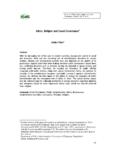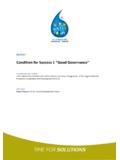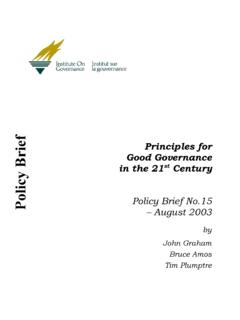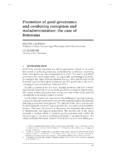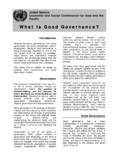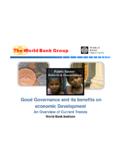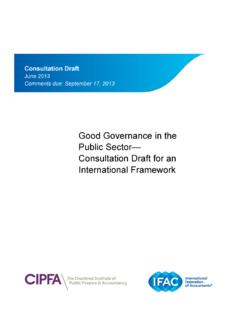Transcription of CHAPTER 4 Botswana’s Success:Good Governance, …
1 Over the past 60 years, botswana s economy hasbeen one of the most successful in the world. Thecountry s achievement is remarkable, because atindependence, in 1966, its prospects were not AND SOCIAL INDICATORSB otswana is a sparsely populated, arid, landlocked country;at independence it was also one of the poorest countries inthe world, with per capita income of just $70 a year. In thefirst few years of independence, about 60 percent of currentgovernment expenditure consisted of international devel-opment assistance. There were only 12 kilometers of pavedroads, and agriculture (mostly cattle farming for beef pro-duction) accounted for 40 percent of gross domesticproduct (GDP).By 2007 botswana had 7,000 kilometers of paved roads,and per capita income had risen to about $6,100 ($12,000at purchasing power parity), making botswana an upper-middle-income country comparable to Chile or success is also evident in other measures of humandevelopment.
2 At independence, life expectancy at birth was37 years. By 1990 it was 60, 10 years above the African aver-age. Under-five mortality had fallen to about 45 per 1,000live births in 1990, compared with 180 for Africa as a assistance has shrunk to less than 3 percent ofthe government budget, and agriculture currently accountsfor only about percent of GDP. Major strides have alsobeen made in infrastructure and growth in per capita income averaged percentbetween 1966 and 1999 (table and figure ). The coun-try s performance is particularly impressive compared withthat of other African economies (figure ).Critics have argued that the social gains from thisgrowth have been somewhat limited. In fact, in addition tothe gains in health and life expectancy noted above, therehave been gains in poverty reduction and education. Theproportion of poor people fell from about 50 percent in1985 to 33 percent in 1994, and the proportion of peoplecompleting at least primary school rose from less than2 percent at independence to about 35 percent in 1994(Leith 2005).
3 Not all indicators are as positive: income distribution inBotswana remains very unequal (the Gini coefficient wasabout in 1994).2 Unemployment remains high, reflect-ing to a large extent rural to urban migration, although ittoo has fallen, dropping from about 21 percent in the 1990sto about 17 percent in AND DEVELOPMENTB otswana s extraordinary growth was fueled by minerals,particularly diamonds. At independence, beef, the country smain export and largest sector, contributed 39 percent ofGDP. From independence until the 1970s, international aiddominated the government budget and was the main sourceof foreign exchange. At that time the mineral sector, mainlydiamonds, began to take off and soon became the dominant81 botswana s success : good Governance, good policies , and good LuckMichael LewinCHAPTER 4sector. Income growth and the growth of the mining sectoraccelerated in tandem from about 1974/75 until the discovery of diamonds as well as otherimportant minerals was clearly an element of botswana s success .
4 However, there is considerable disagreement overwhether the discovery of minerals in a developing economygenerally brings good luck or bad (box ).3 Indeed, manycountries in Africa, including Zambia, Nigeria, the Demo-cratic Republic of Congo, Sierra Leone, and others, havesquandered vast amounts of their natural wealth. One doesnot have to be persuaded that natural resources are neces-sarily a curse to conclude that they certainly are not sufficientfor economic success or even a good predictor of it. In thecase of botswana , minerals turned out to be lucky, but otherkey ingredients in the recipe for success were present, includ-ing good governance and good economic the bad governance curseMineral-based countries seem to be prone to bad govern-ment, a phenomenon Acemoglu and others have termed good economics, bad politics. In almost all developingcountries, the government owns the mineral resources andis therefore the main recipient of the revenues from theirextraction.
5 This concentration of revenues with the govern-ment as the conduit of benefits to the rest of the economycan lead to a host of problems, including rent-seeking, cor-ruption, and the efficiency losses that result from them. It isnot surprising that, with easily accessible wealth concen-trated in the hands of the government, malignant dictator-ships and predatory regimes often thrive. There also seemsto be a greater tendency for armed civil conflict in mineral-based economies (Collier and Hoeffler 2004). These badpolitics are extremely has avoided these manmade disasters. Part ofits success may reflect luck: botswana s relatively homoge-neous population has less potential for ethnic polariza-tion, which when combined with mineral rents can beparticularly combustible. Still, most of the credit must begiven to the leadership, which, since independence, hasdesigned and fostered the conditions of governance thathave ensured stability and social and economic government established respect for property rightsand the rule of law.
6 It maintained a high degree of trans-parency, which was reinforced by continuing the Tswanatribal tradition of consultation. These consultative insti-tutions, known as kgotla, created a degree of trust in thegovernment the sense that government exists to servethe people and promote development and is not theinstrument of one group or individuals for the purpose ofgetting hold of the wealth. Tswana tradition also82 CHAPTER 4: botswana S success : good governance , good policies , AND good LUCKF igure Average Annual Growth in per Capita Incomein botswana , 1980 2008 Table Annual Growth in per Capita Income inSelected Economies, 1966 99 EconomyAverage growth Kong SAR, , Rep. :Adapted from Leith 90 Percent1990 20002000 08 Source:Leith Average per Capita Income in Africa andBotswana, 2001 09(purchasing power parity at current dollar prices)02,0004,0006,0008,00010,00012,000 14,00016,0002001 Dollars2002 2003 2004 2005 2006 200720082009 AfricaBotswanaSource:OECD 4: botswana S success : good governance , good policies , AND good LUCK83 The counterintuitive notion that the endowment of nat-ural resources is a curse rather than a blessing hasbecome received wisdom.
7 Sachs and Warner (1995)report regression results showing that being a naturalresource or mineral exporter reduces a country s devel-opment prospects. Many other researchers find evidenceto support this claim (see for example, Auty 2004 andthe references therein). The fact that most of the EastAsian tigers (the Republic of Korea; Taiwan, China;Hong Kong SAR, China; and Singapore) plus Japan areresource poor has added to the perception that endowedwealth is an obstacle to growth and is certainly evidence that a disproportionatenumber of the poorest countries are dependent onmineral exports. The direction of causality, however, isfar from clear: does mineral dependence retard devel-opment, or does retarded development create mineraldependence? Accounting for the endogeneity of mineral depen-dence overturns the Sachs-Warner conclusions. Coun-tries that fail to develop remain resource dependent,butresource abundancemay be correlated with highergrowth (see, for example, Brunnschweiler and Bulte2008; Alexeev and Conrad 2009).
8 Many rich countries including Canada, Australia, Norway, the United States,and Latin America s top performer, Chile were or aremineral dependent. In Africa the two richest countries,South Africa and botswana , owe much of their wealthto gold and short, resources are not necessarily a curse, butmany countries have squandered their resources, and insome cases, the presence of mineral resources may havecontributed to economic stagnation or decline. What isit about mineral endowments that can make things gowrong?Dutch DiseaseDutch disease refers to the deleterious effects that pur-portedly result from the real appreciation of the cur-rency caused by a booming resource export sector(Corden and Neary 1982). The discovery of mineralsor an increase in their international price leads to anincrease in income and expenditure. As long as some ofthe increased expenditure goes to domestically pro-duced goods, there will be a real appreciation of thecurrency, which causes productive resources to movefrom nonmineral traded goods, the output of whichdeclines, to nontraded goods, the output of whichincreases.
9 The resulting excess demand for tradablescan be financed by the revenue from the the entire process is initiated by an increasein income, expenditure, and consumption, it is not clearwhy it should be thought of as a disease. One reasongiven is the presence of positive externalities in thedeclining sector. The declining traded goods sector isthought to have spillover effects that contribute to long-run growth and industrialization. Hence, the realappreciation caused by mineral exports is said to cause deindustrialization, contributing to poor long-runperformance. Of course, in Africa and botswana inparticular, the declining traded goods sector was agri-culture, not industry (there was no significant industryto deindustrialize). Some might argue that mineralexports prevent the real depreciation needed to indus-trialize. Additionally, it is argued, the mineral sectorfails to stimulate the nonmineral sector through link-ages to the rest of the this effect, one must weigh the advantagesthat minerals bring in terms of increased saving andhence investment, which should offset any loss of com-petitiveness caused by the real exchange rate.
10 Moreover,because government is usually the chief beneficiary ofthe resource revenues, the increase usually eases con-straints on public goods, such as infrastructure, educa-tion, and health, which should contribute to growthand industrialization. If private investment or publicgoods expenditure fails to materialize, the problem liesnot in the real exchange rate but rather in the failure offinancial markets to allocate the saving and investmentproductively or of government to invest Volatility Curse Mineral prices tend to be volatile, which, it is argued,destabilizes the economy (Hausmann and Rigobon2003). This volatility affects the economy through theexchange rate, which appreciates in the boom anddepreciates in the bust, and through fiscal policy, whichtends to be procyclical, leading to inefficient stop-go provision of government services and is argued that the perceived riskiness thatthis volatility engenders leads to lower investment, par-ticularly foreign direct investment, which seeks outsafer markets.










